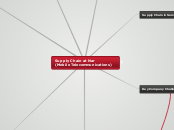arabera Metanet Babayeva 9 years ago
612
Supply Chain at Azerfon (Telecommunications)

arabera Metanet Babayeva 9 years ago
612

Honelako gehiago
CRM is the management of the relationships between the providing organization and its customers.
Customer service provides information from the customers and has the ability to give customers real-time information on product
availability, price, and delivery.
By expanding beyond the core organization, a need to monitor performance is needed. Some of the key measures of effective supply chain management include cost,service,productivity, use of assets, and quality.
This is often implemented through monitoring customer perceptions and identifying best practices as benchmarks to evaluate supply chain performance.
External linkage - Capable of linking external organizations, especially within supply chains
Modular- An open system architecture allowing incorporation of those modules needed for the organization
Comprehensive- Integrating as many business computing func-tions as possible, with a single database
Best business practices - Incorporation of processes evaluated as the best in the world
Procurement activities are planned well ahead. Annual Integrated Procurement Plan is prepared together with internal customers. CAPEX and OPEX purchasings are clearly divided between category managers(buyers). The main KPIs in time, quality and cost related
Reverse Logistics
3rd and 4th Party Logistics
Warehouse Management
Transportation
Reliability
Ease of use
Product and service features
Advertising & packaging
The quality of customer care
It is quite a challenge to find a seasoned supply chain specialist (manager) in our Country. It is even more challenging to find a person matching your set of values and norms.
So, one of the challenges of the company is to find right people and develop needed functional capabilities with the organization
Establish/streamline key Supply Chain processes to achieve Effectiveness and Efficiency and SIMPLICITY.
Effectiveness is the extent to which a customer’s requirements are meat.
Efficiency is the measure how economically a company's resources are utilized
1. Support the business with the deployment of strategic actions
2. Proactive and speedy reactions towards market changes
3. Simple decision-making and approval procedures
On time delivery of ordered goods and services is very imporatant in every industry including Telecomunnications. As the many orders affects the CUSTOMER (CONSUMER) SATISFACTION this becomes a competitive advantage
1. Develop effective teams, both functional and cross-functional
2. Strengthen functional capabilities
3. Leverage experiences and best practices in the Company
1. Invigorate and streamline key processes
2. Eliminate duplications and unnecessary rework
3. Establish governance and clarify roles and responsibilities
1. Speed up deployment of new value propositions to the market
2. Enhance foresight and ability to react to market changes
3. Accelerate decision-making and approval procedures
1. Ensure delivery of highest quality of service for Nar customers
2. Enhance customer orientation and focus on segment needs
3. Establish end-to-end accountability for the customer experience
Maximisation of experience for customers
Maximisation of performance for employees and other resources
Minimisation of idle time for resources
Minimisation of waiting time for customers
Services are perishable. They cannot be saved, stored, resold or returned. More importantly,they cannot be inventoried. A service company may use inventory management (e.g., for spares) but this accounts for a very small part of the overall service operations.
Services are simultaneously produced and consumed. Mass production is difficult. Customer satisfaction is in “real time” with the customer “observing” and“participating” in the process.
Services are heterogeneous. No two customers or employees are precisely alike. Human interaction makes defining quality a challenge and it may vary from one customer to the next.
Services are intangible. They cannot be seen, felt, tasted or touched in the same manner astangible goods. The customer usually bases its judgment on peripheral cues andexperiences.